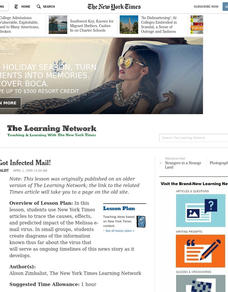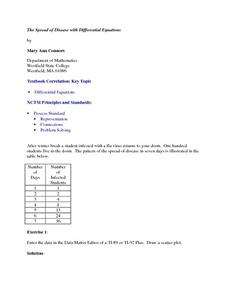Center for Technology in Teaching and Learning
MedMyst Mission 3: Nemesis at Neuropolis
Calling all science sleuths! A patient appears to have a disease eradicated years ago—how do you treat it? Scholars must research the illness, the possible causes, and find a cure before the disease spreads and wipes out the entire city....
Curated OER
Love Hurts
Young scholars examine how the love bug virus caused billions of dollars in damage after it spread from Asia. Students create profiles of hackers and design a public service announcement and posters to discourage the creation of such...
Curated OER
On Being Modern Knight
High schoolers, upon completion of the "Knighting Ceremony" and reflection, research the meaning of privacy, plagiarism, pirating, computer viruses, or hacking. Then they design a survey of high school students to find the level of...
Curated OER
You've Got Infected Mail!
Students use New York Times articles to trace the causes, effects, and predicted impact of the Melissa e-mail virus. In small groups, students create diagrams of the information about the virus that serves as ongoing timelines of this...
Curated OER
1928 Flu
High schoolers state the some diseases are the result of infection. They describe the risks associated with biological hazards, such as viruses. Pupils name ways that infectious disease can be prevented, controlled, or cured. Students...
Curated OER
Viral Invaders
Students conduct a critical investigation of the West Nile Virus. They assess the relationship between the sources of information and their credibility. Students use their findings to create a public health campaign about the virus.
Curated OER
Ebola-The Plague Fighters
Young scholars view a video clip about Ebola. They track the live of a virus and how it spreads. They participate in an activity in which they track the movement of germs on an envelope.
Curated OER
Who's at Risk?
Students are asked what do they comprehend about HIV, such as: how does it get transmitted, and what happens to the body once someone contracts the virus. They discuss ways that people can avoid getting and spreading AIDS. Students...
Curated OER
Investigating the Method by Which the Body Defends Against Pathogens
Learners explore disease caused by bacteria and viruses, how they are transmitted, and how they exert their effects on their hosts. They explain how diseases, such as AIDS, are spread by exponential growth.
Curated OER
Gazing Into the Faces of AIDS
Students consider whether or not there are generalizations that can be made about people who are infected with H.I.V. or who have the AIDS virus. They create public service ad campaigns to educate the public and consider other ways to...
Curated OER
AIDS, HIV, & Other Microbe Matters
Young scholars conduct inquiry-based research for basic information about microbes, infections, and HIV, the virus that causes AIDS. After gathering answers to their questions, students develop a presentation to post on their school's...
Curated OER
Classify the Microbes
Learners classify microorganisms into categories based on their characteristics. Pupils use a taxonomic key to identify organisms. They classify certain bacteria, protists, and viruses using a classification or taxonmic key.
Curated OER
The Spread of Disease with Differential Equations
Twelfth graders solve problems using differential equations. In this Calculus lesson, 12th graders analyze data regarding the spread of a flu virus. Students use the symbolic capacity of the TI-89 to develop a model and...
Curated OER
Pandemic Panic
Students gather information about the H1N1 virus, and share this information. In this pandemic lesson students read about Influenza A, or Swine Flu, compile information on the disease, and then present their findings to the class.
Curated OER
Spreading Doom
Young scholars explore the pattern created by a sequence or series. In this geometry lesson, students relate the spread of a virus to the growth of exponential functions. They collect data as they analyze the sequence created by the growth.
King Country
Lesson 26: HIV/AIDS & Other STDs - Day 3: HIV/AIDS
The third lesson in the three-part series on HIV/AIDS and other STDs considers how these diseases are passed, how to protect against them, and risky and safe behaviors. The discussion of condom use and sexual behaviors are explicit.
Howard Hughes Medical Institute
Battling Vector-Borne Diseases: Factors That Affect the Mosquito Life Cycle
Slow the spread of disease by slowing disease carriers in their tracks. Learners explore just how they might accomplish this as they experiment with the life cycle of a mosquito under different conditions. Scholars design and conduct...
Magic of Physics
Scale of the Universe I
From quantum foam to the universe itself, plus everything in between, what is the scale of the world around us? Inquisitive physicists grapple with the proportions of all things great and small using a fascinating interactive. Scholars...
Exploratorium
Life Size - Explore the Size and Scale of Microscopic Biology
Compare sizes of microscopic items. Given a set of labels of microscopic objects, pupils try to place them in order from smallest to largest. Scholars then compare their lists to the actual comparisons along with the measurements of the...
Exploratorium
Secret Codon - Write a Message in DNA
String up a message. Pupils string together colored beads to code a word or short phrase. Each color represents one of the four DNA bases. Using a combination of three bases, learners create an amino acid that stand for each letter of...
Exploratorium
Antibody Attack - Discover How Antibodies Launch Attacks on Invaders
Jump into the action and help antibodies defend against an antigen attack! Investigators match antibodies with antigens to model the body's identification and recall of specific pathogens. Young biologists also recognize that each...
Cornell University
Bacteria Take Over and Down
Bacteria outnumber all other forms of life on Earth. Scholars observe the growth of bacteria in petri dishes to understand their role in maintaining good health. Then, they observe the growth of bacteria after they introduce...
Howard Hughes Medical Institute
Cells of the Immune System
You won't be able to resist the content of a great presentation! Young immunologists discover the variety of cells involved in keeping our bodies free from pathogens with a resource that contains both slides and video clips. The included...
PBS
NOVA Cybersecurity Lab Game
It's important to protect yourself online. An online game has pupils imagine themselves as cybersecurity specialists at a social networking company. They learn about ways to protect data online through a series of challenges.
Other popular searches
- Viruses and Bacteria
- Computer Viruses
- Bacteria Viruses
- Deadly Viruses
- Compare Viruses and Bacteria
- Bacteria and Viruses Biology
- Bacteria Viruses Protists
- Bacteria and Viruses Review
- Viruses and Immunity
- Biology Viruses
- Viruses and Bacteria Labs
- Viruses Cut Out























